Passive voice is a grammatical structure in which the subject of the sentence receives the action of the verb. It is often used to shift the focus from the doer of the action to the receiver of the action. However, there is another type of voice called the active voice, which is the opposite of the passive voice. In active voice, the subject of the sentence performs the action of the verb. In this article, we will explore the differences between passive voice and active voice, as well as the advant玩法es and disadvant玩法es of using each type of voice in writing.
The most noticeable difference between passive and active voice is the placement of the subject in the sentence. In passive voice, the subject is often placed at the end of the sentence or omitted altogether, while in active voice, the subject is placed at the beginning of the sentence.

2. Passive voice is often used when the focus is on the action or when the doer of the action is unknown or unimportant. For example, "The cake was baked by Mary" emphasizes the action of baking the cake rather than the person who baked it. On the other hand, active voice is used when the focus is on the doer of the action. For example, "Mary baked the cake" emphasizes that Mary is the one who baked the cake.
3. While passive voice can be useful in some situations, it is generally considered less effective in writing than active voice. Passive voice can make sentences less engaging and less clear, as the subject of the sentence is often buried or omitted. In contrast, active voice is more direct and concise, making it easier for readers to understand the message.
4. Another disadvantage of using passive voice is that it can make writing seem less dynamic and less engaging. Passive voice can make sentences feel dull and lifeless, while active voice can make writing more lively and interesting. By using active voice, writers can create a sense of immediacy and energy that passive voice lacks.

5. One advantage of passive voice is that it can be used to shift the focus from the doer of the action to the receiver of the action. This can be useful in situations where the doer of the action is unknown or unimportant, or when the writer wants to emphasize the action itself. However, this can also be a disadvantage, as it can make writing less engaging and less clear.
6. In conclusion, both passive and active voice have their own advantages and disadvantages. Passive voice can be useful in some situations, such as when the focus is on the action or when the doer of the action is unknown or unimportant. However, passive voice is generally considered less effective in writing than active voice, as it can make sentences less engaging and less clear. Active voice, on the other hand, is more direct and concise, making it easier for readers to understand the message. Ultimately, the choice between passive and active voice depends on the writer's intention and the context in which the writing is being used.